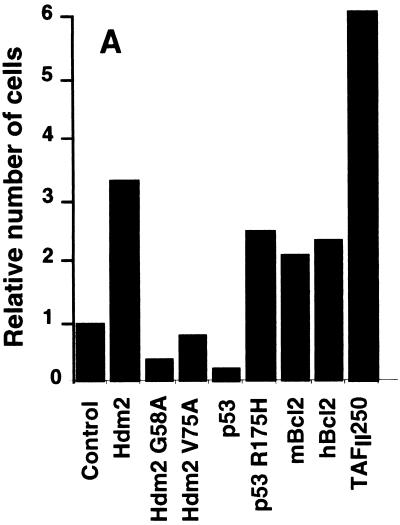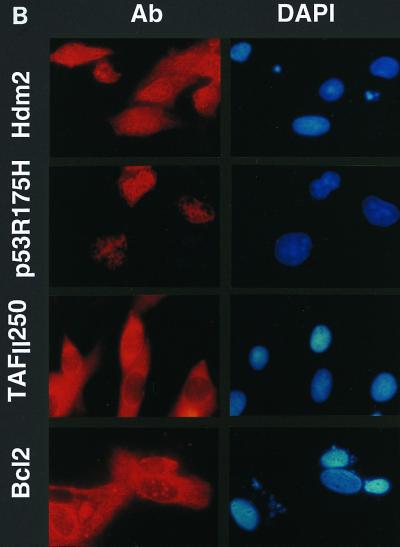FIG. 6.
Survival of tsBN462 cells selected at the nonpermissive temperature. (A) The survival assay, using selection at the nonpermissive temperature, was performed essentially as described by O'Brien and Tjian (42). tsBN462 cells were transfected with 5 μg (9-cm plates) of vectors expressing nothing (control), Hdm2, Hdm2 G58A, Hdm2 V75A, p53, p53 R175H, mBcl2, hBcl2, and TAFII250, as indicated, and 1 μg of pSG5-lacZ (all plates). Parallel plates were transfected with 0.5 μg of pEGFP. After 16 h in the presence of the precipitate, the cells were washed, incubated for 24 h, trypsinized, and replated at half the density. An aliquot was removed to measure β-Gal activity (to correct for variations in transfection efficiency). The plates transfected with pEGFP were observed under a fluorescence microscope. The cells were incubated overnight at 32°C and then for 7 days at the nonpermissive temperature (39°C). The medium was changed every 2 days. To measure the number of surviving cells, they were trypsinized and the viable cells that excluded trypan blue were counted with a Bürker slide. The numbers of cells were adjusted for variations in transfection efficiency and expressed relative to the control empty vector. There were approximately 106 cells per 9-cm plate for TAFII250 at the end of the experiment. Similar results were obtained in two independent experiments (±10%). (B) Following selection the cells were fixed, stained with specific antibodies (Hdm2, IF2; p53, DO1; TAFII250, anti-HA, 12CA5; Bcl2, sc-509 [Santa Cruz]) followed by Cy3-labeled secondary antibodies and DAPI (nuclei). The cells were photographed under a fluorescence microscope. Control plates incubated with the specific antibodies and labeled secondary antibodies gave low levels of background fluorescence (not shown). The antibodies are specific for exogenous proteins.


